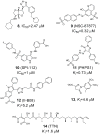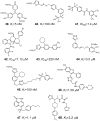Small molecule tools for functional interrogation of protein tyrosine phosphatases
- PMID: 22816879
- PMCID: PMC3495087
- DOI: 10.1111/j.1742-4658.2012.08718.x
Small molecule tools for functional interrogation of protein tyrosine phosphatases
Abstract
The importance of protein tyrosine phosphatases (PTPs) in the regulation of cellular signalling is well established. Malfunction of PTP activity is also known to be associated with cancer, metabolic syndromes and autoimmune disorders, as well as neurodegenerative and infectious diseases. However, a detailed understanding of the roles played by the PTPs in normal physiology and in pathogenic conditions has been hampered by the absence of PTP-specific small molecule agents. In addition, the therapeutic benefits of modulating this target class are underexplored as a result of a lack of suitable chemical probes. Potent and specific PTP inhibitors could significantly facilitate functional analysis of the PTPs in complex cellular signal transduction pathways and may constitute valuable therapeutics in the treatment of several human diseases. We highlight the current challenges to and opportunities for developing PTP-specific small molecule agents. We also review available selective small molecule inhibitors developed for a number of PTPs, including PTP1B, TC-PTP, SHP2, lymphoid-specific tyrosine phosphatase, haematopoietic protein tyrosine phosphatase, CD45, PTPβ, PTPγ, PTPRO, Vaccinia H1-related phosphatase, mitogen-activated protein kinase phosphatase-1, mitogen-activated protein kinase phosphatase-3, Cdc25, YopH, mPTPA and mPTPB.
© 2012 The Authors Journal compilation © 2012 FEBS.
Figures













References
-
- Tonks NK, Neel BG. Combinatorial control of the specificity of protein tyrosine phosphatases. Curr Opin Cell Biol. 2001;13:182–195. - PubMed
-
- Zhang ZY. Protein tyrosine phosphatases: prospects for therapeutics. Curr Opin Chem Biol. 2001;5:416–423. - PubMed
-
- Ostman A, Hellberg C, Bohmer FD. Protein-tyrosine phosphatases and cancer. Nat Rev Cancer. 2006;6:307–320. - PubMed
Publication types
MeSH terms
Substances
Grants and funding
LinkOut - more resources
Full Text Sources
Other Literature Sources
Molecular Biology Databases
Research Materials
Miscellaneous

